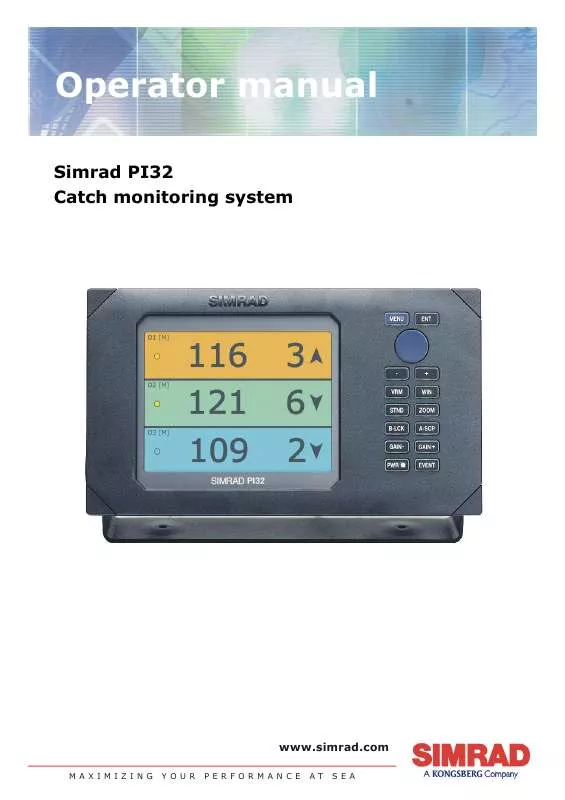User manual SIMRAD PI32
Lastmanuals offers a socially driven service of sharing, storing and searching manuals related to use of hardware and software : user guide, owner's manual, quick start guide, technical datasheets... DON'T FORGET : ALWAYS READ THE USER GUIDE BEFORE BUYING !!!
If this document matches the user guide, instructions manual or user manual, feature sets, schematics you are looking for, download it now. Lastmanuals provides you a fast and easy access to the user manual SIMRAD PI32. We hope that this SIMRAD PI32 user guide will be useful to you.
Lastmanuals help download the user guide SIMRAD PI32.
You may also download the following manuals related to this product:
Manual abstract: user guide SIMRAD PI32
Detailed instructions for use are in the User's Guide.
[. . . ] Operator manual
Simrad PI32 Catch monitoring system
www. simrad. com
MAXIMIZING YOUR PERFORMANCE AT SEA
857-164636 / Rev. A
Simrad PI32 Catch monitoring system
Operator manual
Important notice
Operation of the PI32 Catch monitoring system assumes that the communication between the Operator Unit and the sensors is fully functional. Ensure that the communication channels and update rates defined on the Operator Unit matches those of the sensors.
About this document
Rev Rev. A Date 04. 12. 05 Original issue Written by RBr Checked by KRa Approved by KRa
© 2005 Simrad AS ISBN 82-8066-059-3 All rights reserved. No part of this work covered by the copyright hereon may be reproduced or otherwise copied without prior permission from Simrad AS. The information contained in this document is subject to change without prior notice. [. . . ] Any attachment material "permanently" attached to the sensor's charging lugs must not form an electrical connection between the two charging lugs shorting the charging current. (A) = Two wires with a snap hook in one end and the other end attached permanently to (B). (C) = Safety wire with snap hooks on each end. Note that the upper end is NOT attached to the purse seine wire.
112
857-164636 / Rev. A
Sensors
Tuna purse: The sensor must not be attached to the footrope wire, but to the foot-rope chain. Use a safety wire in addition in case the sensor is ripped off the net.
Trawl or Danish seine: The depth sensor is normally attached to the headrope (A). For secure fastening and stable positioning of the sensor pointing towards the vessel, make a fine mesh bag (B) located at the centre of the headrope. Size two snap hooks (C) approximately 10 - 15 cm from the headrope forming a bridle, and keep the sensor stretched by means of two rubber straps (D) attached to the aft fastening lugs.
857-164636 / Rev. A
113
Simrad PI32
PI Height sensor
Purpose
The PI Height sensor monitors the current height of the trawl, as well as the rate of any height changes. All measurements are related to the bottom.
(A) = The PI Height sensor is normally mounted on the headrope, and by means of the built-in echo sounder it will measure the distance to the bottom. (B) = Echo sounder transmission field
Main parts
(A) = Negative charging and fastening lug (B) = Positive charging and fastening lug (C) = Communication link (D) = Location of sensor lamp (E) = Water switch sensor (F) = Echo sounder transducer - must be directed towards the seabed!
114
857-164636 / Rev. A
Sensors
Daily operation
Once installed and put to use, the Height sensor will automatically be switched on once the waterswitch is activated. After an initial startup, the sensor starts the echo sounder, and the depth results are transmitted to the vessel. When the sensors are not in use, check that the sensor lamp (D) do not flash from time to time, as this indicates that the sensor is on and is discharging its batteries. In this case, wash the sensor in fresh water to remove salt and dirt. If you operate with Fast update rate, the sensors must be charged approximately every 35 hours. Used with Normal or Slow update rates, the operational life is approximately 60 or 250 hours respectively. The optimal sensor charging temperature is from +10 to +25°C. The sensor can only be charged with the PI Charger.
Note:
Charging sensors at sub-zero temperatures can create explosive gasses. Simrad AS assumes no liability for the improper charging of sensors or the use of chargers not specified in Simrad's sensor charging documentation.
Numerical presentation
On the PI32 display, the distance to the bottom is displayed in the numeric display. If the height is increasing or decreasing, this is shown with two arrows and the variation in meters per second. When the readings are stable, the digits are shown in black colour. When the values are predicted, the digits are grey, and if the contact is lost, the characters *. * * are shown in grey. (C) = Current distance from the sensor to the bottom. (D) = The distance is decreasing by 1 meters per second. [. . . ] Using a multimeter, check the DC current between the negative charging lug (A) and the water detector (B). - With the initial sea water switch and a a fully charged battery, the current should not exceed 150 µA. - With a redesigned sea water switch (sacrificial bolt) and a a fully charged battery, the current should not exceed 67 µA. - If you measure 0 µA, check the fuse on your multimeter. [. . . ]
DISCLAIMER TO DOWNLOAD THE USER GUIDE SIMRAD PI32 Lastmanuals offers a socially driven service of sharing, storing and searching manuals related to use of hardware and software : user guide, owner's manual, quick start guide, technical datasheets...manual SIMRAD PI32


 SIMRAD PI32 BROCHURE (1530 ko)
SIMRAD PI32 BROCHURE (1530 ko)
 SIMRAD PI32 QUICK REFERENCE GUIDE REV A (281 ko)
SIMRAD PI32 QUICK REFERENCE GUIDE REV A (281 ko)
